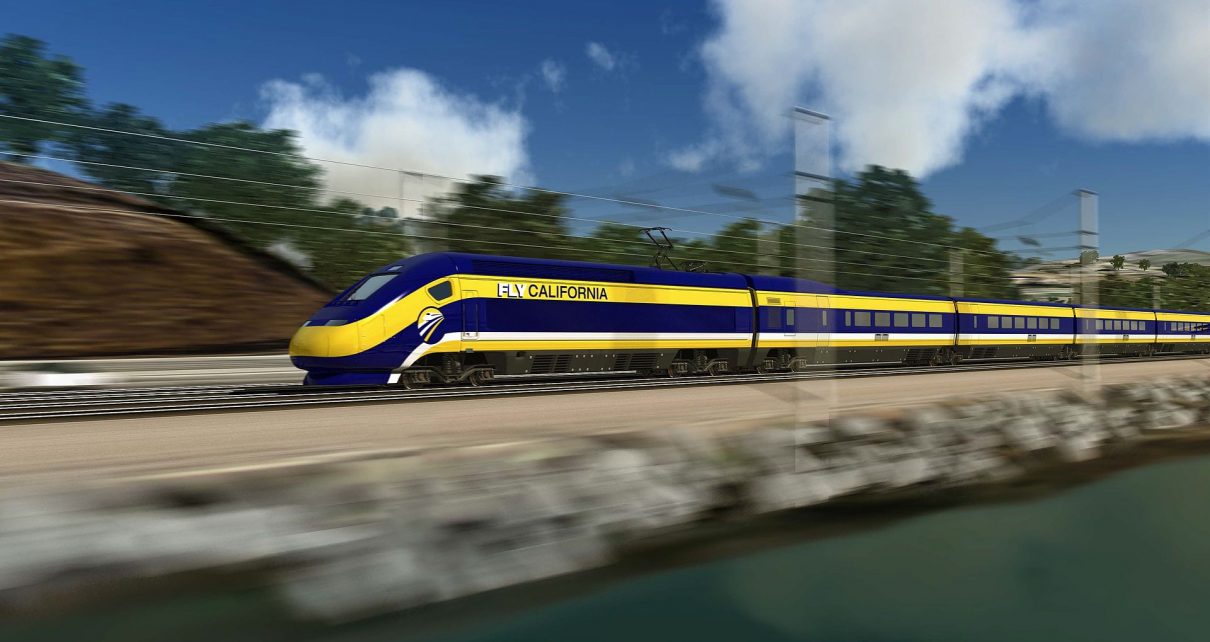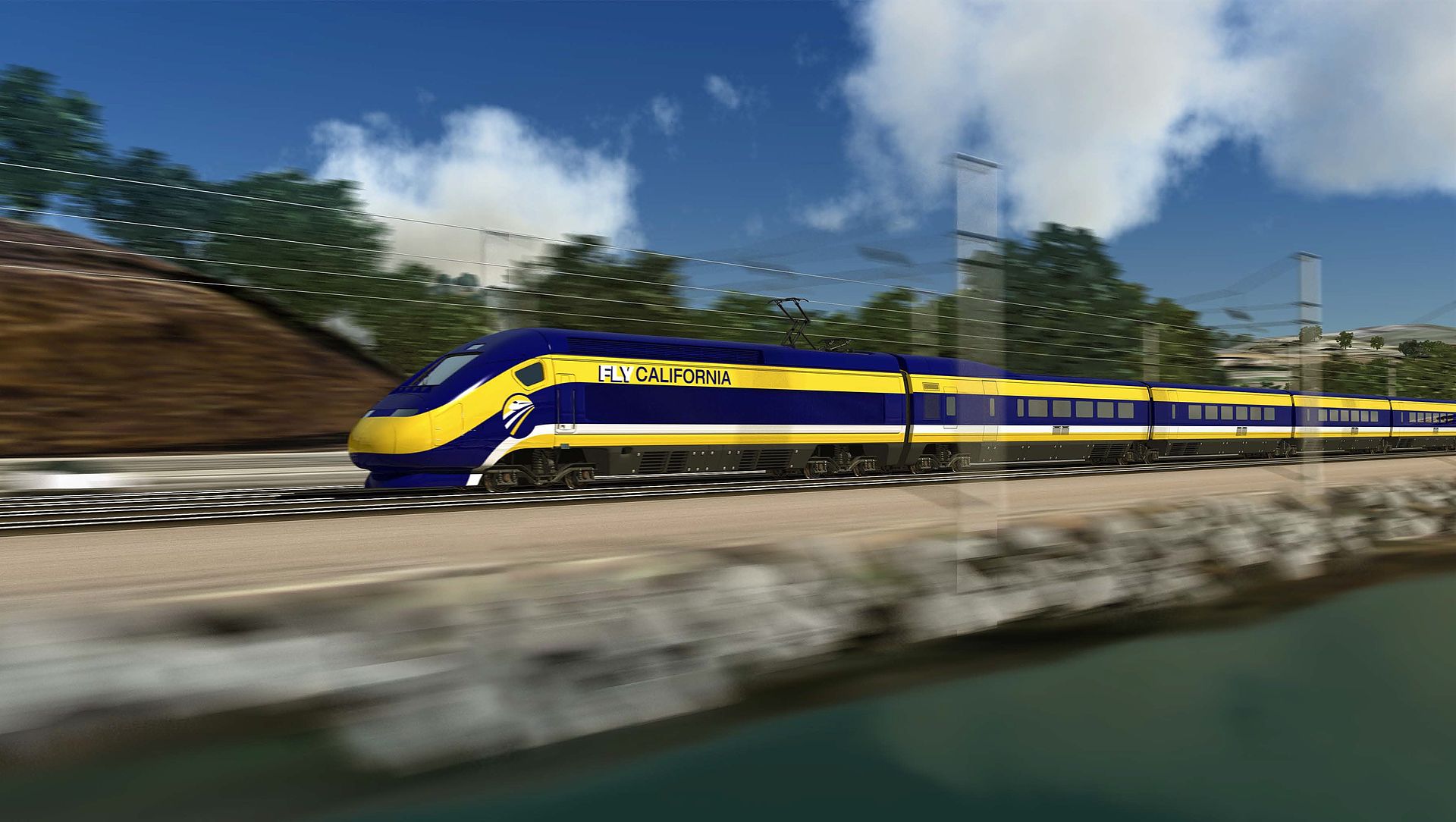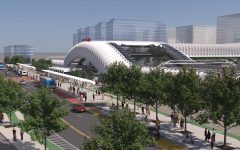
High Speed Rail train, artists rendering. (Photo: CHSRA.ca.gov)
California High Speed Rail: Low Speed Fail
HSRA claims it will build own power system but costs more than NASA’s Artemis project
By Thomas Buckley, December 11, 2022 2:30 am
Curiouser and curiouser, said Alice as she grew taller and taller in Wonderland.
Curiouser and curiouser, said everyone paying even the slightest attention as the high-speed rail fantasy grew bigger and more expensive and further behind schedule and more incomprehensible and more ludicrous and now, yes, even possibly taller and taller in California.
According to the High-Speed Rail Authority’s (HSRA) October “2022 Sustainability Report” (see below for PDF link,) the HSRA now says it will power the entire system by itself using only renewable power and have no impact on the state’s already wheezing electrical grid (since it will never be completed, it’s kind of a moot point, but, anyway…)
The report states that “(W)e have identified an effective strategy for 100% renewable energy: solar generation with battery storage on land that we own.”
That means the HSRA believes it can build enough renewable power infrastructure to generate the equivalent of the electricity (3 billion kilowatts each year) needed to power about 434,000 California homes.
So let’s do some math – 434,000 households is the equivalent of about 1.2 million people, which is a bit less than the population of San Diego or about equal to the population of Anaheim, Oakland, and Long Beach combined.
If, as the report claims, only solar (and the needed battery systems to power the trains at night) is used, that would require the construction of the equivalent of about three Blythe Solar Power Projects. The feds say the project is 4,070 (plus significant non-panel covered acreage) acres in size, which in turns means one single plant to cover the rail system’s needs would have to be about 16,000 acres, or about the same physical size as Palo Alto.
Of course, if the solar farm is laid out in a linear fashion along the tracks to keep it “on land that we own,” estimating the exact acreage covered becomes rather difficult, especially considering city restrictions, the ability – or lack thereof – to build solar panels and batteries on bridges and viaducts, etc.
The cost is also difficult to estimate, but tripling the Blythe cost translates into a minimum of $3 billion (and that was built in one flat empty space in the desert on federal land.) The number of panels alone needed ranges upwards of 10 million.
As with everything numerical to do with the project, it should be noted that that $3 billion estimate is what it would cost private industry to build it in one place on very cheap, if not free, land today. It does not contemplate it being built over the coming decades and in many different places (let alone in a linear fashion track-side) and it being done by the wildly incompetent HSRA. Suffice to say, even though it may save about $500 million a year in electricity bills, it will, if the rest of the project’s fiscal actualities are followed, cost at least 7 times that amount, eating up – through equipment replacement, maintenance, etc. – the vast majority of that supposed savings.
It is possible – given their history of employing malleable language – that the HSRA was referencing only putting the batteries on their property (along the tracks?) and buying only solar power from the existing grid. But that, too, would require similar massive new solar farms so as not to crash the grid, especially considering the fact that the electric car mandate itself will most likely overwhelm the system on its own. Doubtful, but the statement may have been written to provide a fuzzy back door for the HRSA’s “promise.”
UPDATE: It should be noted that this, for lack of a better term, hybrid power approach does not seem to be the preferred option for the HSRA.
The report continues: “(S)taff are further refining the steps for power generation and renewable power purchases where necessary. The most promising strategy is to use land owned by the Authority for solar generation and battery storage resources. We will finalize the procurement strategy, continue socialization and coordination with regulatory bodies, and possibly seek additional grant funding in 2022.”
To sum up – they really really want to create their own power system and they really really need extra free money to do so.
If wind power – and not the “only solar” referenced in the report – is used the numbers become a little more credible. Using the most modern, largest, most powerful wind turbines (the “taller and taller” referenced earlier) available, making sure they are perfectly placed, etc., it would require at least 1,000 (very rough estimate, could be as low as 500, could be more depending upon the technology) of them. Assuming they are dispersed along the tracks, that would necessitate about 350 miles of turbines (not including battery space, maintenance lay-down areas, etc.) That spatial requirement does not contemplate where such turbines would/could go in urban areas or in places that are not windy enough.
On a positive note, the report notes that HSRA has planted 7,100 trees to help offset the greenhouse gases the project has created. However, it is unclear if that figure takes into account – or balances against – the thousands and thousands of trees – Central Valley orchards, etc… – it has cut down so far.
It should also be noted the report proudly cites the HRSA’s commitment to environmental justice, stating it’s policy to “(P)romote and protect community members’ rights to participate meaningfully in environmental decision-making that may affect them…” However, it is quite likely that any number of Central Valley land and business owners who have been forced to sell up (and wait for years to get paid) would challenge that statement.
The report also noted that the entire construction fleet will consist of “zero emission vehicles” by 2035. While a putatively laudable goal, it can also be taken as an admission of the fact that the project will NOT be completed before then as there would be no need to have any ZEV’s is the work is done.
On the cost side of the project, if the $100 billion estimate for cost of the Los Angeles to San Francisco phase of the project is taken seriously, that means the remaining portions – Merced to Sacramento and LA to San Diego – will cost an additional $60 billion and require an upping of the power needs discussed above by about 60 %.
That $60 billion figure does not take into account the fact that the portion of the line slated to run down the I-15 corridor from Temecula to San Diego will be one of the most expensive. The topography of the line would require – as high-speed trains run best on flat tracks and have obvious problems with inclines – many many very very expensive viaducts and tunnels (if you have driven the route, you can visualize the problem quite easily.) Just that 50 or so mile segment could eat up tens of billions of dollars, driving the final price closer to $200 billion.
For comparison, NASA’s Artemis program – which in phase one involves four round-trips to the moon over the next four years– costs about $93 billion. Delving back into the math, Artemis ships sill travel about 1.9 million miles for a cost of about $48,690 per mile or about 77 cents an inch.
Using the questionable HSRA number of $100 billion for its phase one, the project is costing about $192 million a mile or about $3,035 dollars an inch, or about 4,000-times as much.
To reiterate: 4,000 times the distance traveled cost to go to the moon.
Finally, while the HSRA makes no mention of it on their website and did not issue a press release about this seemingly major development, only four weeks ago the authority apparently hired a Texas firm – AECOM – to take over as project manager responsible for “program planning and strategy; environmental and engineering management; infrastructure delivery; supply chain management; and federal and state funding support.” In other words, pretty much everything.
Wonder why the HSRA didn’t tell anyone?
Interested in the company managing the project? Here is the AECOM press release announcing the deal and their website:
https://www.webwire.com/ViewPressRel.asp?aId=296552
And here’s the HSRA sustainability Report:
https://hsr.ca.gov/programs/green-practices-sustainability/sustainability-report/
And here is a link to a recent Hoover Institution paper on the project:
- Biden Speech Showed He is an Incompetent, a Thief, a Liar and Personally Hateful and Vicious - July 24, 2024
- Public Money for Teacher Housing - July 24, 2024
- A Clown Car Conspiracy - July 22, 2024




HSR = is the train version of FTX for democrats.
Nailed it!
Exactly. The CEO of FTX testifying before Congress says that they were using Quick Books to do their “accounting” for a multi-billion dollar enterprise. What is the HSRA using? Anything?
A bootleg copy of Lotus 1-2-3 they found on the “mainframe” (i.e. a Gateway 386 laptop).
Does nobody in government have a conscience anymore? If I had worked with California HSR, be it directly or indirectly, I would have deleted my Linked-In profile years ago, anything else connecting me to this fraud and then killed myself. Sadly none of the perpetrators of this crime will ever feel the guilt in conscience or courtroom.
Waiting2inhale, it’s obvious that none of these HSRA directors have even a trace of the kind of conscience you suggest, that would cause them to halt or even downsize this ridiculous project: https://hsr.ca.gov/about/board-of-directors/board-members/. They are in the process of building the equivalent of a Chinese ghost-city (no inhabitants) funded on debt.
This is about endless graft and cost overruns. Should they ever get this nightmare up and running it will be an endless source of problems and demands for ever more money.
This high speed rail thing has nothing to do with moving people from LA or San Diego to San Francisco faster. It has to do with ego and legacy.
Ronald, you are absolutely correct. It’s Jerry Brown’s legacy project. Every time we get close to someone shutting it down they change their mind – probably bc they’re reminded that this project cannot die. It’s a complete travesty and debacle.
Arnold Schwarzeneggar…a Republican…gave the go-ahead to start building.
Sounds like a solid, sustainable, obtainable, ecological, progressive plan to me.????
What could possibly go wrong?
Uggh, someone, anyone, pull the plug on this boondoggle!
someone is definitely making money for this.
I would not be surprised to learn how many “consultants” are related to the leadership or staff of the high speed rail authority…
If I was a professor at a graduate Business school, this hideously mis-managed Train to Nowhere would be the #1 study as an example of a coordinated debacle/public financial rape amongst Politicians, and Unions! This event is so completely TOXIC that no one dares to put their hand near this inferno of corruption!! AND THEY ARE STARTING A NEW ONE FROM LA TO LAS VEGAS………….ABSOLUTE & UTTER INSANITY FROM THE DEMOCRATS!!
A bunch of mo-fo’s should be stood up against a wall and executed — SHOT! — for this fiasco, which is turning out to be unions’ best friend and taxpayers’ worst nightmare! This monster is NEVER GONNA DIE!
WHO is building the trains?
WHO is building the solar panels used to SUPPOSEDLY power the trains?
WHO did Governor Gavin Newsom enter into a no-bid contract for PPE gear in the very early stages of the plandemic? Which company ALSO builds trains, buses and other transportation equipment???
Build Your Dreams is an apt name for this company, which is probably providing kickbacks to Newsom, Pelosi and many other Democrats involved in this rammed-through project that is so poorly planned out that it will never get built, but the funding continues and the Democrats undoubtedly “round-trip” a percentage, like “ten percent for the Big Guy”…
The Democrats are nothing but clever when it comes to personal enrichment feeding off the public trough, and boondoggle projects like this….
This train was never meant to be built!! It was just a way to steal billions of dollars from taxpayers. The latest plan of building their own environmentally friendly power system is just a creative way to steal more money. And of course the majority of idiotic Californian’s would never object to “helping” the environment.
Solar farms are an ugly blight upon the land. No doubt there are payoffs promised to High-Speed Rail Authority’s Board of Directors and top management for proposing solar generation with battery storage on taxpayer owned land? Maybe the payoffs from solar panel and battery manufacturers with CCP connections?
It’s still being built, so while you write this ridiculous, ill-informed article, the rest of California realizes we can’t just keep expanding highways and causing pollution in neighborhoods where people live. Something needs to change. We can’t keep worshipping 20th century infrastructure projects while the rest of the developed world moves ahead of us at high speed.
The article is completely accurate and well researched! Let me dumb this down so even you can understand it T.M. IF they really cared about pollution and traffic they could have easily built the train right along highway 5 where they already have the land and it’s flat and ready to lay down track. But they don’t want to build a train, they want to take money!
Ummm, I think your math comparing to SLS is missing something….
For $93 Billion SLS will only move a few (less than 20) passengers for the distance, with no real value left over, except for some used hardware that will be collecting dust. Meanwhile the high speed rail projects will have right-of-ways established, and (way too much) infrastructure that will be used by many thousands of passengers over many decades. (conservatively) . The construction projects that have been forced to be built due to pre-existing right-of-ways are pretty crazy, with so very many tons of concrete elevated in the sky. But all that will be here for a long time after the remaining SLS components are sitting in science museums around the country.